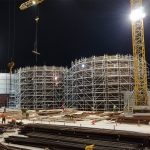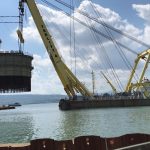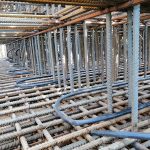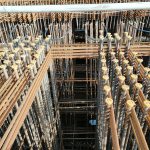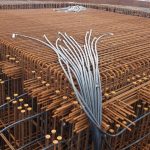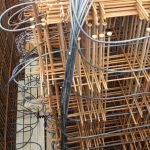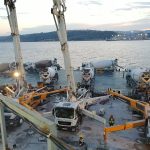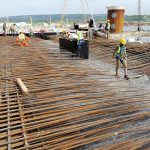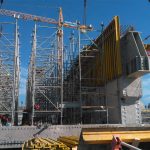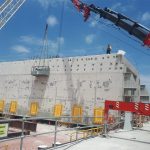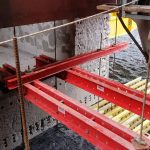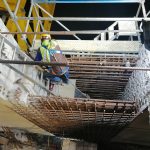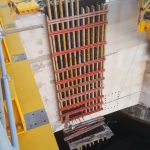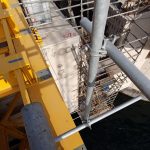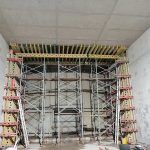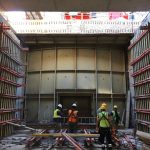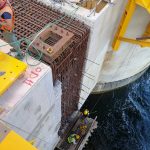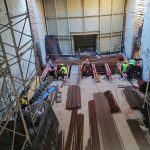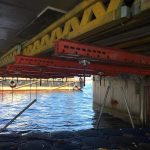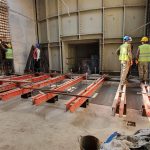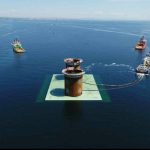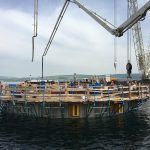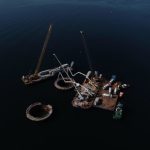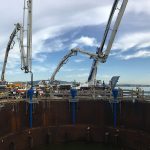1915 Çanakkale Bridge
1915 Çanakkale Bridge, interconnecting the continents of Europe and Asia, with a tower height of 318 meters, is the longest suspension bridge of the world with its mid-span of 2.023 meters.
Project Summary:
Project Name: 1915 Çanakkale Bridge and Highway
Customer: T.R. Ministry of Transport and Infrastructure, General Directorate of Highways (KGM)
Employer: Çanakkale Highway and Bridge Construction Investment and Management Inc. (ÇOK A.Ş.)
Main contractor: DL E&C – Limak – SK ecoplant – Yapı Merkezi Joint Venture (DLSY JV)
Project Model: Build – Operate – Transfer
Highway length: 88 km
Bridge length: 4608 m
Medium span: 2023 m
Tower Height: 318 m
Route: Malkara – Çanakkale
Number of Strips: 2×3
Project start: Mar.17
Total investment cost: 10,354,576,201.85 Turkish Liras (2016)
Based on conventional techniques of suspension bridge construction, plinths and tie-beams are built once caissons constituting the foundation of the towers are immersed in seabed. Through use of an innovative technique implemented in this project for the first time in the world, plinths and tie-beams were constructed onshore, saving significant project time.
There were four plinths, one for each pier. Cylindrical shaped plinths had 19 meters of diameter and 10,5 meters of height each. The installation of plinth rebar was initiated onshore while the caissons were at the construction stage on the dry docks. The rebar was installed onshore on a steel rebar cage. 2.220 tons of rebar (555 tons per plinth) was installed in 7 months.
After the installation of rebar on the steel rebar cage, outer formworks were placed, completing the installation of the plinth formwork onshore. Then, the anchorage frames were placed within each plinth, concluding onshore constructions.
Once assembled, each plinth together with the rebar reinforcement, steel formwork, rebar cage and anchorage frame weighed approximately 1.000 tons. Each plinth was taken from the onshore construction site by a floating crane after the immersion of each caisson to be installed on to the shafts. As a result, through use of the innovative technique described above, the installation of rebar, formwork and anchorage frame of plinths was completed in advance onshore and only the concrete castings were made offshore.
Each of the plinth rebars which ensured anchorage with the shaft, requiring high level of precision during installation, were placed under the tight supervision by a surveyor. 1058 reinforcement bars, penetrating the shafts, were arranged in a way to go through the studs placed 10 cm apart from each other.
As a result of YÜCE YAPI’s precise work, all four plinths were installed successfully on shafts at first trial, without any disruptions or rework.
While the works of rebar installation of the plinths were in process onshore, YÜCE YAPI installed the cooling pipes necessary to cool down the hydration temperature that may arise during the concrete casting also onshore. 23.697 meters of cooling pipes were laid inside the structure with 70 cm of distance vertically and 60 cm horizontally for each plinth.
YÜCE YAPI also carried out the pressure tests of the pipelines and completed cement injections into the cooling pipes after concrete castings.
11.616 m³ of concrete was casted offshore for the plinths. For the concrete casting of these plinths, four floating barges were used, three of them to transport the transmixers and one for concrete pumps. Concrete was casted using steel tremie pipes.
Formwork, rebar and concrete construction of the upper half of the side walls and top slabs of the tie-beams interlocking the plinths were performed by YÜCE YAPI.
Bottom slabs and lower side walls of the tie-beams had been constructed onshore. These tie-beams were carried onto the floating barge by a floating crane. The top slabs and upper side walls were built on the floating barge.
PERI vario climbing system was used for the wall formwork installation of two tie-beams with a height of 8 m and a length of 24 m. PERI heavy loading slab formwork system was used as carrier for the top slab. The side walls and top slabs were casted at one time on the floating barge and the construction of the tie-beams was completed.
The tie-beams on the floating barge were brought to the tower locations by tugboats. The floating barges, placed between the plinths, were lowered by flooding water and tie-beams were installed on the plinth cantilevers. As a result temporary installation of tie-beams was completed.
The reinforced concrete construction of the gap having remained between the tie-beams and plinths has been made by YÜCE YAPI.
Concrete casting of each stitch location was performed in two phases. Bottom slab was casted during the first phase and the sidewalls and top slab were casted together during the second phase.
The reinforcements of the stitch location were connected to the plinth and tie-beam using couplers, ensuring rebar integrity between these two structures.
PERI vario formwork was used for the formwork installation. The formwork parts were taken onto the plastic floating barge for the bottom slab construction, and they were assembled and installed on-site. Since the construction location was 1.5 m above the sea level, the bottom slab formwork was suspended to the SRU Steel Waler, extended from the plinth to the tie-beam with tie-rods. Following the completion of the suspended formwork, the bottom slab rebars were connected to each other with couplers. After the completion of the bottom slabs’ concrete castings, working scaffoldings were installed at the inner and outer parts for the side walls for rebar and embedded item installation.
Then the top slab and inner side wall formworks were installed with the erection of the slab scaffolding. After the completion of the installation of the top slab rebar and embedded elements of the working platform, the outer formworks of the side walls were installed and the side wall and top floor concrete casting were finalized.
Following the completion of the immersion procedure of the caissons, the offshore concrete casting of the steel shafts was performed by YÜCE YAPI. A total of 4.224 m³ of self-compacting concrete, 1.931 m³ of it on the European side and 2.293 m³ on the Asian side was casted by using 17 units of tremie pipes.

